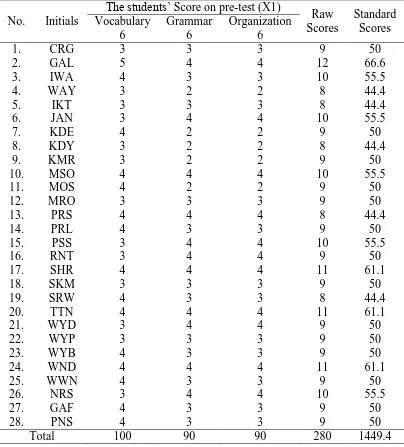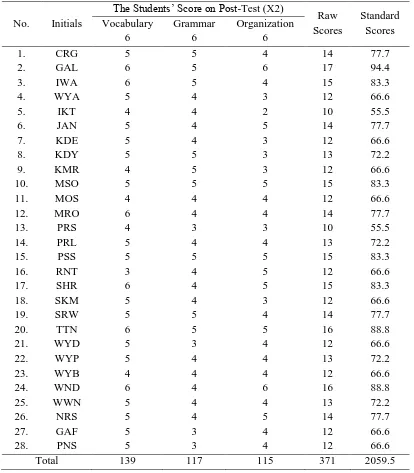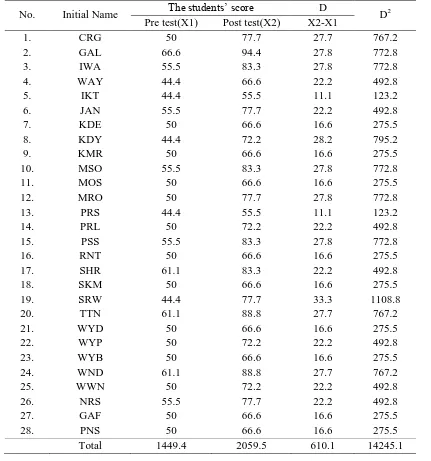e-Journal of English Language Teaching Society (ELTS) Vol. 2 No. 2 2014 – ISSN 2331-1841 Page1
IMPROVING THE EIGHTH GRADE STUDENTS
’
ABILITY IN
WRITING SIMPLE DESCRIPTIVE PARAGRAPH THROUGH MIND
MAPPING TECHNIQUE
Nurul Hidayah1, Sriati Usman2, Abdul Waris3
Abstract
This research was conducted in order to prove whether the use of mind mapping technique was effective or not to improve writing ability in descriptive paragraph of the eighth grade students at SMP Negeri 2 Rio Pakava. It used pre- experimental research design. She took class VIII C to be the sample by using purposive sampling technique. The data of the research were collected by using observation and test. The result of observation was analyzed descriptively; meanwhile the test was analyzed statistically. The test divided into two; pre-test and post- test that were given. Based on the result of pre- test and post- test, it was found that the tcounted was 19.9 by applying 0.05 level of significance with
27 degree of freedom (df= 28-1=27), we got ttable value of 1.703. It shows that
the tcounted value is higher than the ttable. It means that the use of mind mapping
technique can improve the writing ability in descriptive paragraph of the eighth grade students at SMP Negeri 2 Rio Pakava.
Keywords: Improving; Ability; writing; Descriptive paragraph; Mind Mapping.
INTRODUCTION
In Indonesia, English has been learnt formally from junior high schools up to universit y l evel . English is a compulsor y subj ect for almos t all schools students in Indonesia, and they have to acquire four language skills learning English. They are listening, speaking, reading and writing. Based on the curriculum of Junior High School, KTSP (2008), states that listening and reading are productive skills while speaking and writing are receptive skills. It means that the students at Junior High School are expected to be able to master the language skills.
Based on the basic competence for eighth grade, the students deal with many kinds of the texts such as descriptive text, recount text, narrative text, and also procedural text. Students
e-Journal of English Language Teaching Society (ELTS) Vol. 2 No. 2 2014 – ISSN 2331-1841 Page2 must have capabilities in writing. Writing is another way of communication and interaction that takes place between the writer and the reader. It is presented by using graphic, symbol or letters. Such symbols have to arrange words and the words are arranged to form sentences. The sentences or the number of sentences are related to each other. Wilson (1981:1) argues:
“writing is a sequence of sentences arranged in a particular order and linked together in certain
ways.” However, the sequence is very short, consisting of two or three sentences, and even one sentence form a coherent provided that they are put in the aggregate and have relationship. It is usually called a text. Nunan (2003:88) states that “writing is a form of communication and process of expressing and impressing ideas into a product of writing: translating out thought
into language.” It means in writing the people can share anything that they want to write such
as their experiences or what they feel.
In relation to the importance of writing, Hairston (1986) points out that:
1. Writing is a tool discovery. We stimulate our thought process by the act of writing and top into information and images we have in our unconscious mind. Writing
help us to “harvest” what we know.
2. Writing generates new ideas by helping us to make connections and see relationships.
3. Writing help us to recognize our ideas and clarify concepts by writing ideas can arrange them in coherent form.
4. Writing on a subject makes active learners rather than passive receivers of information.
Writing has some elements that are very important to be acquired by any writer in order to produce a good and concise the writing product. The elements are grammar, vocabulary and organization. The organization contains many kinds of transition signal. The use of transition signal will guide the reader to follow the ideas easily. Oshima and Hogue (2005:27) argues that think of transition signals as traffic signs that tell the reader when to go forward, turn, slow, down, and stop.
e-Journal of English Language Teaching Society (ELTS) Vol. 2 No. 2 2014 – ISSN 2331-1841 Page3 others if it was presented by using correct grammar. Many students could not make a good writing because of using incorrect grammatical sentences. The last problem was that they had difficulty in organizing one sentence with other sentences. So, the students had no motivation to write.
Relating to the problem faced by the students’, the teacher is required to have an
appropiate technique of teaching. Mind mapping was a simple technique for drawing information in diagrams, instead of writing it in sentences. The diagrams always took the same basic format of a tree, with a single starting point in the middle that branches out, and divides again and again. The tree was made up of words or short sentences connected by lines. The lines that connect the words were part of the meaning. Buzan (2008) points out, “ by using mind mapping, you can quickly identify and understand the structure of a subject and the way that pieces of information fit together, as well as recording the raw facts contained in normal
notes.” So, the students could make a good writing by using this technique.
METHODOLOGY
In conducting the research, the writer applied pre-experimental research design to find
out that mind mapping can develop the students’ ability in writing simple descriptive paragraph
at SMP Negeri 2 Rio Pakava. The sample of the research was one group and there was no control group. The writer applied the pre-test and post-test pre experimental design as seen in the formula (Arikunto, 2006:85).
Where
01: Pre-test 02: Post-test X : Treatment
The research design above represents the use of pre-experimental research. There was a pre-test (01), treatment (X), and post-test (O2). The pre-test was given before treatment while post-test was given after treatment. So, the writer only compared the result of the research between pre-test and post-test.
e-Journal of English Language Teaching Society (ELTS) Vol. 2 No. 2 2014 – ISSN 2331-1841 Page4 This design provides some improvements over the first for the effects of the treatment are judged by difference between the pre-test and the post-test scores. No comparison with a control group is provided (Best, 1981:81).
The population of this research was eighth grade students of SMP Negeri 2 Rio Pakava. It consisted of 3 parallel classes: VIII A, VIII B, and VIII C. The sample was class VIII C with 28 students.
The result of the students’ score in the pre-test and post-test was analyzed statistically.
To determine the individual’s standard score, the writer applied the formula (Purwanto, 1991:102) as follows:
Where:
NP = individual score
R = obtained score SM = maximum score 100 = constant number
After getting the individual standard score, the writer counted the mean score of group. The writer used the formula proposed by Sukardi (2009:88) as follows:
Where:
M = mean score
∑x = total score
N = number of students
The writer then applied a formula by Sukardi (2009:90) to find the mean deviation of the pre-test and post-test difference from each student as follows:
e-Journal of English Language Teaching Society (ELTS) Vol. 2 No. 2 2014 – ISSN 2331-1841 Page5 Where:
D = deviation score
N = the number of the students
Then the writer calculated the data in order to know the significance between the pre-test and post-pre-test or the effectiveness of the treatment, the writer used formula proposed by Sukardi (2009:91) as follows:
√
Where:
t = the value of t counted
D = the mean deviation of pretest-posttest difference (post-test –pre-test)
∑D = the sum of deviation score
1 = constant number N = the number of students
FINDINGS
1. PRE- TEST
e-Journal of English Language Teaching Society (ELTS) Vol. 2 No. 2 2014 – ISSN 2331-1841 Page6
Table 1. The Scores of the Students Pre-Test
No. Initials
The students’ Score on pre-test (X1)
Raw
By looking at the table above, the mean score of the pre-test could be seen in the following computation:
=
e-Journal of English Language Teaching Society (ELTS) Vol. 2 No. 2 2014 – ISSN 2331-1841 Page7
2. POST- TEST
After giving treatment for six times, the writer gave post-test to the students to measure
the effectiveness of mind mapping technique in improving the students’ ability in writing
simple descriptive paragraph. The writer conducted post- test on 9th October 2013. The result of the post test was presented in the following table:
Table 2. The Score of the Students Post-Test
No. Initials
The Students’ Score on Post-Test (X2)
e-Journal of English Language Teaching Society (ELTS) Vol. 2 No. 2 2014 – ISSN 2331-1841 Page8 By looking at the table above, the mean score of the post-test could be seen as follows:
=
= 73.5
3. THE RESULT OF THE STUDENTS’ DEVIATION
The result of the students’ square deviation can be seen on table below:
Table 3. The deviation of pre-test and post-test scores
e-Journal of English Language Teaching Society (ELTS) Vol. 2 No. 2 2014 – ISSN 2331-1841 Page9 Based on the table above, the writer computed the mean deviation for the group as shown as below:
Where:
D = Deviation score
N = the number of the students
D = X2 – X1 = = 2059.5 – 1449.4 N 28 = 610.1 = 21.8
28
After known the sum of square deviation of the group, the writer needed to analyze the data statistically in order to know the significant difference of the pre test and post test by using formula proposed by Sukardi as below:
√
Where:
t = the value of t counted
D = the mean deviation of pretest-posttest difference (post-test – pre-test)
∑D = the sum of deviation score
1 = Constant number N = the number of students
e-Journal of English Language Teaching Society (ELTS) Vol. 2 No. 2 2014 – ISSN 2331-1841 Page10 post-test aiming at know the students achievement in writing simple descriptive paragraph and also knowing whether or not the implementation of mind mapping technique in teaching writing simple descriptive paragraph to the eighth grade students of SMP Negeri 2 Rio Pakava is effective.
The pre-test was done before the treatment given to the students. The aim of pre-test
was to know the students’ writing ability, especially in using vocabulary, grammar and
organization before treatment. The most difficult one for the students based on the result of
pre-test was in grammar and organization. It can be seen by seeing the percentage of the students’ mean score. The students’ mean score in grammar was 53.6%, while in organization also
53.6%. The students’ mean score in vocabulary was 59.5%. The standart score of the school was 60. By comparing the stantard score, it can be seen that most of the students got low score. The highest score of the students on pre-test was 66.6 and the lowest one was 44.4. The percentage of students who got score in pre-test lower than 60 was 85.7%. It indicates that only 4 students (14.3%) who got ≥ 60. There were 5 students (17.8%) who got lowest score and only 1 student (3.6%) who got higher score. It indicates that most of the students did not know well yet how to make a good paragraph.
e-Journal of English Language Teaching Society (ELTS) Vol. 2 No. 2 2014 – ISSN 2331-1841 Page11 this technique, the writer explained to the students what mind mapping is and how this technique is applied. The material in each meeting described about people and animals. When the writer gave the example in mind mapping, the students were so interested and enthusiastic in learning process. After that, the writer asked them to make a simple descriptive paragraph by describing people and animals. In the process, the students were so active to finish the task. They asked the writer the vocabulary that they did not know, told their friend around the material, and walked around the class to borrow dictionary. If they have finished it, they directly asked the writer to know the result of their task.
After the treatment conducted in the class, the writer gave the post-test to show the progress in writing. The model of pre-test and post-test was alike. The students finished their task faster and they look more confident in doing writing than before. In contrast to the pre-test
result, the students’ score for post-test was improved. The students’ mean score in grammar was 69.6% , organization was 68.4%, while vocabulary was 82.7%. Only 2 students who got the lowest score 55.5. There were 1 student who got the highest score 94.4. The percentage of students who got the lowest score was 7.1% and there were 92.8% students who got ≥ 60. It
means that there is an improvement of students’ writing skill. They already knew how to make
a simple descriptive paragraph by using mind mapping technique. However, they must study hard to achieve higher score and know well how to make a good paragraph.
In relation to the research finding above, a similar research has been done by Kurniasari (2011). She used mind mapping technique to made the students interest in teaching and learning process and in order to know the students’ ability in writing recount text. The result of this research has shown that the students progress in improving writing ability. It means that
mind mapping technique can improve students’ writing ability. A similar research also done by Mulyana (2013). The result of this research shows that mind mapping can improve the
students’ ability in writing descriptive paragraph. In conducting her research, she applied true -experimental research design. She found that the value of ttable was (2.017) and the value of
tcounted was ( 9.043). It showed that tcounted was higher than ttable.
Mind mapping is one of effective technique and it is useful in teaching and learning writing process. Mind mapping technique can make the students easier to arrange sentences into good paragraph and not difficult to write their ideas and to express their opinion. Buzan
e-Journal of English Language Teaching Society (ELTS) Vol. 2 No. 2 2014 – ISSN 2331-1841 Page12
concentration and motivation”. It could help the students to learn more effectively, to improve the way to record information, and to memorize their ideas easily. Finally, the writer concludes that the use of mind mapping technique can improve the students writing ability in writing simple descriptive paragraph of the eighth grade students of SMP Negeri 2 Rio Pakava.
CONCLUSION AND SUGGESTIONS
After analyzing the data statistically, the writer draws conclusions based on the data presentation and analysis. It is found the value of tcounted (19.9) is higher than the value of ttable
(1.703). It was proven that the use of mind mapping technique can improve the writing ability in descriptive paragraphs of the eighth grade students of SMP Negeri 2 Rio Pakava. Applying mind mapping technique to the students can motivate them in learning English well, especially in writing a simple descriptive paragraph. It is shown by looking at their participation and enthusiastic during the treatment. In short, the use of mind mapping technique helps the students to get many ideas and help them to find appropriate vocabulary.
Based on the conclusion above, the writer would like to suggest some ideas for improvement the quality teaching English. In the teaching and learning process, we need to apply this technique in teaching writing especially descriptive paragraph. The students enjoy, get motivated, get many ideas and stock of vocabulary. The teacher should actively encourage
and attract the students’ motivation in the class in order to make them energetic and do not get
bored in studying English. Also, the teacher should attract the students’ attention by giving the students the materials which are interesting and easy to understand by them.
REFERENCES
Arikunto, S. (2006). Prosedur Penelitian Suatu pendekatan Praktis. Jakarta: PT. Rineka Cipta. Best, J.W. (1981). Research in Education. New Jersey: Englewood Cliffs.
Buzan, T. (2008). Mind Map Untuk Anak- Anak. Jakarta: Gramedia Pustaka Utama. Departemen Pendidikan Nasional Ditjen Manajemen Pendidikan Dasar dan Menengah
Direktorat Pembinaan Sekolah Menengah Pertama. (2008). Kurikulum Tingkat Satuan Pendidikan(KTSP). Jakarta
e-Journal of English Language Teaching Society (ELTS) Vol. 2 No. 2 2014 – ISSN 2331-1841 Page13 Kurniasari, A. (2011). Using Mind Mapping to Improve Students’ Ability in Writing Recount Text (An Experimental Research of the Eighth Grade Students at SMP Negeri 9 Palu). Palu: Tadulako University, Unpublished Skripsi
Mulyana . (2013). The Effectiveness of Using Mind Mapping in Descriptive Text to Improve Writing Ability of the Eighth Grade Students at SMP Negeri 19 Palu. Palu: Tadulako University, Unpublished Skripsi.
Nunan, D.(2003). Theory of Writing. Jakarta: Perpustakaan Universitas Pendidikan Indonesia. Oshima A. and A. Hogue. (2005). Writing Academic English. London: Oxford University
Press.
Purwanto, M. (1991). Prinsip- Prinsip dan Teknik Evaluasi Pengajaran. Bandung: Remaja Posdakarya.
Sukardi, (2009). Metodologi Penelitian Pendidikan (Kompetensi dan Prakteknya). Jakarta: PT Bumi Aksara.


